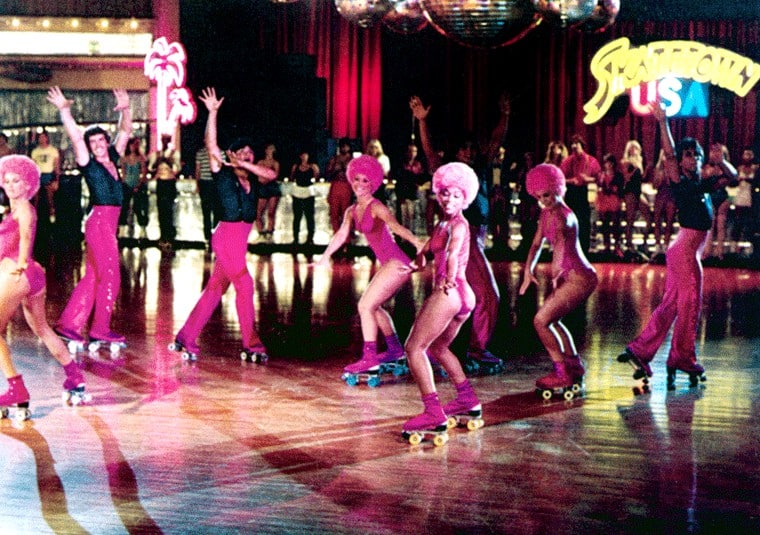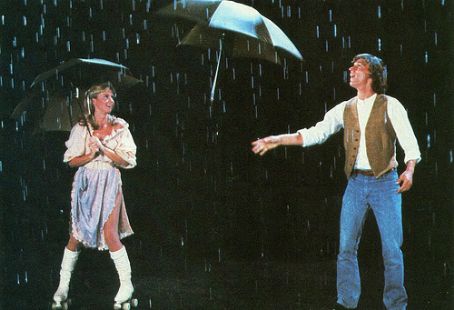Roller skating as a pastime for the rich & famous lasted barely a year, but resulted in some of the best in 70s kitsch cinema.
It’s now easier than ever to see what our favorite (and not-so-favorite) celebrities eat, drink, and do for fun. Because “celebrity” is conflated with “knows a lot about things,” fans tend to jump right on those various bandwagons, sometimes for good, such as 2014’s “Ice Bucket Challenge,” sometimes less so, as evidenced by the popularity of “skinny tea,” and, if you want to go a little darker, Jenny McCarthy personally leading the troubling decline in childhood vaccinations. Such things makes one long for the days not just when we knew a little less about celebrities, but when their hobbies were more benign, like Jazzercise or transcendental meditation. Some of them were even cute, like roller skating.
The beautiful people turning what was mostly an activity for children into a glamorous pastime didn’t even last a year (that year being 1979), but when it hit, it hit hard. Roller discos opened up in New York and Los Angeles. People ran a cover story on the trend, claiming that everyone from John F. Kennedy, Jr. to Andy Warhol to Jack Nicholson (who reportedly owned a pair of skates trimmed with neon green tubing) was into it. Cher was a particularly big fan, even performing a song called “Hell on Wheels” (the B side of which was brilliantly titled “Git Down (Guitar Groupie)” and filming a video in which she’s chased down by truckers while wearing roller skates.
Episodes of Charlie’s Angels and CHiPs featured the main characters going undercover on the roller disco scene to solve a crime. In November of 1979, ABC aired Playboy’s Roller Disco & Pajama Party, in which a 53 year-old Hugh Hefner toddles around on skates while clinging to a woman young enough to be his daughter, and James Caan, presumably after snorting a Playmate’s weight in blow, boogies in the background while wearing overalls with no shirt underneath.
Now, you might be thinking “Surely no one was going to try to get a full ninety minute movie out of a bunch of people skating around in circles, right?” You’re absolutely correct — nobody tried to make a movie about the roller disco craze. There were, in fact, three of them, all gloriously trapped-in-amber moments of 70s glitz and excess, all frantically attempting to cash in on a trend that was over before it had barely started.

The first was Skatetown, U.S.A., released in October of 1979, a purported comedy about a night in the life of a Los Angeles roller disco in which every square inch is covered in neon, strobe lights, and white powder. Skatetown, U.S.A. is a textbook example of what happens when you both (a) try to make a movie for everyone, and (b) do it under the direction of a pile of cocaine brought to life and made flesh. Though roller skating appealed mostly to teenage girls, the movie also features slapstick humor for boys, tight shots of spandex-clad boobs and butts for Dad, and some shirtless beefcake for Mom.
With the frenetic “something’s constantly happening” pacing of a Zucker-Abrahams-Zucker production, it’s at least four different movies overlapping each other: a half-assed take on West Side Story, a talent show featuring professional skating troupes, a drug comedy, and a showcase for some of the least funny comedians of the 70s, including Murray “The Unknown Comic” Langston, and Bill Kirchenbauer, here doing a hilarious impersonation of a Vietnam veteran suffering from post-traumatic stress disorder. There’s also a mysterious “space wizard” who can shoot laser beams from his fingers, because why wouldn’t there be?
Skatetown, U.S.A. also marks the feature debut of a stunningly handsome Patrick Swayze, perfectly cast as a roller skating gang leader named “Ace” who’s often compelled to take his shirt off. Does he give a good performance? Not particularly, but he has charisma to spare, which is more than can be said for Greg Bradford as his good guy rival, and Katherine Kelly Lang as the woman they fight over, who barely speaks. All three of them are overshadowed by roughly 37 supporting characters, each of them doing their very own thing, including “Pistol Pete,” a Mexican bandito stereotype who shoots live guns as part of his skating routine, a glassy-eyed Maureen McCormick, nips on full display, as the hero’s sister, and a snack bar cook who’s so grotesque he’s like a lost member of the Sawyer Family from The Texas Chainsaw Massacre.
If I haven’t entirely sold you on Skatetown, U.S.A. yet, then perhaps I should tell you about Welcome Back, Kotter’s Ron Palillo, who’s so much doing his own thing it’s not entirely clear whether he knew what movie he was in. Wearing a studded slave collar and with his hair in a majestic white man Afro, he’s ostensibly comic relief as one of Ace’s henchmen, but stares at everyone with murder in his eyes, like he’s in a gritty crime drama. Skatetown, U.S.A. isn’t a good movie by any definition of the word, but it’s fascinating to see what a genuine cinematic rush job looks like. It’s a wonder someone remembered to cut the tags off the actor’s costumes before filming began.
A big lump of coal for the Christmas season was Roller Boogie, notably mostly because it was Linda Blair’s last mainstream film before doing stuff like Chained Heat and Savage Streets. While it manages to narrow things down to two plots, they’re a boring “opposites attract” plot combined with a “we gotta save the community center from the rich developer” plot. There’s not nearly enough roller skating, and way too much time spent on two personality-free characters doing a bad job of acting like they don’t like each other, and an even worse job of acting like they do.
Blair plays a rich, Julliard-bound flautist who hears the siren’s call of the roller disco, a decision that shocks her mother so much she hits the pill bottle. Jim Bray is her working class love interest, who dreams of joining the U.S. Olympic roller skating team — a team that, as of almost 2020, does not actually exist, but, eh, details. While generating negative chemistry, Blair and Bray skate through “slobs vs. snobs” comedy and some limp drama about mobsters trying to buy out the local roller rink, and, lacking the amphetamines-fueled pacing of Skatetown, U.S.A., it’s not terribly entertaining.
Like its predecessor, Roller Boogie’s primary issue (not that it would be a masterpiece otherwise) is that it has no idea what audience it’s trying to appeal to. While again, outside of L.A. roller skating was an activity popular mostly with teenage and adolescent girls, Blair occasionally wears outfits that are so skimpy they might as well be bathing suits, and an unacceptable amount of time is spent on Bray and his friends’ tiresome “showing up for a fancy party in a tuxedo t-shirt” antics. Considering that the friends all have names like Phones, Hoppy, and Gordo, it feels like the movie may have originally started out as “Animal House on wheels,” but thankfully someone with slightly better judgment (and probably a little less high) prevailed.
As opposed to its predecessors, Xanadu, released in the summer of 1980, settled on one plot, yet somehow managed to be the most incomprehensible of the three. Very, very loosely based on the 1947 musical comedy Down to Earth, it stars Olivia Newton-John as a muse who descends from the heavens and immediately falls in love with a struggling artist played by Michael Beck, a black hole from which no charisma can escape. She inspires Beck to team up with Gene Kelly on a can’t-miss business proposition: a combination roller disco/rock club and 1940s big band lounge.

There’s something poignant about this, considering that the film very briefly touches upon the power of nostalgia in an ever-changing world. By the time Xanadu was in theaters, the “roller disco” was already out, replaced by less flashy smalltown skating rinks, where the vibe was more “Hokey Pokey” than “Hot Stuff,” and if you wanted drugs you had to buy them out in the parking lot from some kid’s creepy older brother. Like The Apple and Can’t Stop the Music, both of them also released in 1980 and also massive flops, Xanadu tried to capture lightning in a bottle long after the lightning had already struck and fizzled out. That the film ends with Beck and Kelly’s club being presented as if it was the coming together of two different worlds for a bright and exciting future is, frankly, a little depressing.
That being said, there’s a wholesomeness to Xanadu that the earlier films lack. It’s surprisingly earnest, which is not a word one often uses to describe a movie that’s capitalizing on a rapidly dying fashion trend. Most importantly, it knows exactly who its audience is, and that’s reflected in the ribbon barrettes in Newton-John’s hair, and her cute but chaste peasant dresses. There’s even a charming animated sequence (by none other than Don Bluth) portraying Newton-John and Beck as fish and birds, and in human form their romance doesn’t get any further than some light smooching and a few trips around a skating rink. Though both actors were in their 30s at the time, they might as well be a couple of teenagers on a Mormon-sponsored trip to the local Roller-rama.
Though Xanadu died a quick and merciful death at the box office, its soundtrack, a collaboration between Newton-John and Electric Light Orchestra, became a massive hit, with no less than five Top 20 singles, including the title track, and “Magic,” which was used to very creepy effect in a season two episode of HBO’s The Leftovers. Had the film been released a year earlier, when roller discos were still a thing, it might have been a Saturday Night Fever level smash. Alright, that’s probably a bridge too far, but regardless, if you’re a decrepit Gen X’er who’s looking for a taste of sweet, uncynical kitsch, and you want it served up on a pair of quads, Xanadu is the one you want to go with. See you on the floor for all skate!